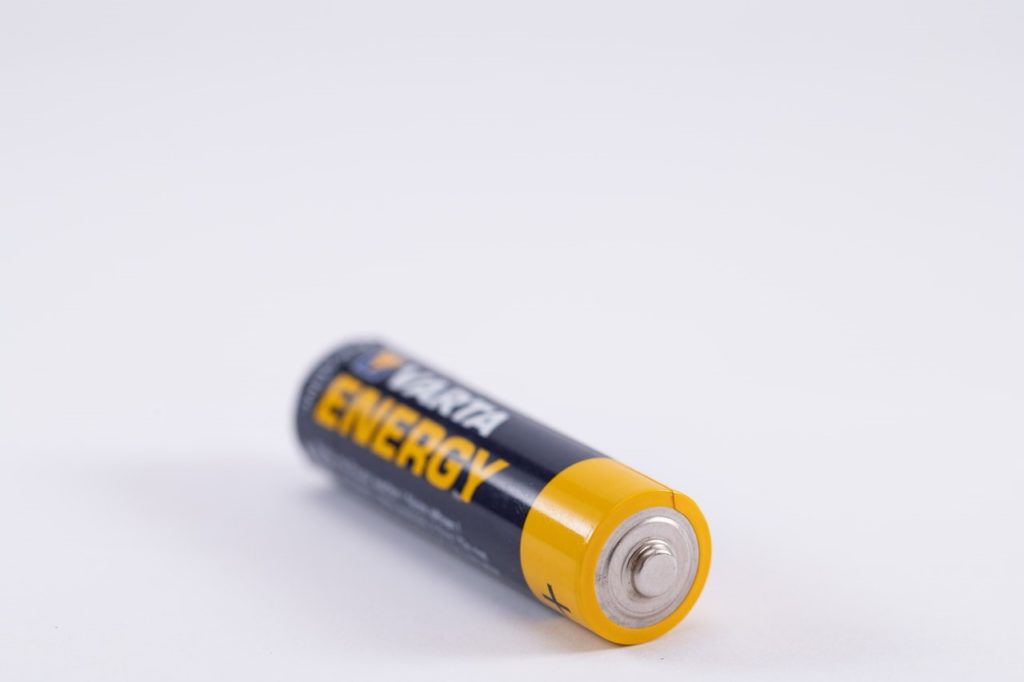
I learned this today. A battery works because the chemical reaction within it produces electrons.
There are different kinds of batteries that use different chemicals, but the general principle is the same. A battery is an energy storing unit. The energy is stored in the form of chemical energy. A chemical reaction happens that causes electrons to flow from one material to another. These electrons, when connected to a circuit, provide an electric current. The electrons have to have somewhere to flow from and to, and this is why batteries have a + and a – end. The – is called the anode and it is the negative electrode. The + is called the cathode and it is the positive electrode.
Two reactions happen inside the battery. The first is that the anode is dissolved by the chemical in the battery and electrons are stripped from the atoms, leaving ions. The ions flow through the separating chemical, leaving the electrons by the anode. Electrons carry a negative charge, and the anode has a negative charge, so they repel each other, but the electrons cannot move through the chemical inside the battery, so they are stuck by the anode. This chemical layer is known as a separator and it stops the electrons moving inside the battery. It has to be a material that ions can pass through but electrons can’t. This is why the battery doesn’t produce electricity when it is not connected in a circuit. The second chemical reaction happens at the cathode. The ions from the anode pass through the separator, and attach to electrons that are already there. There are more ions than there are available electrons, so it makes a deficit of electrons. When a wire is connected from the anode to the cathode, the negative electrons are now free to rush towards the positive cathode, making an electrical circuit. The anode keeps producing electrons and the cathode keeps accepting them until the chemical in the battery runs out or the circuit is disconnected.
The first battery was invented by Alessandro Volta in 1800. He called it a voltaic pile. He made a stack of zinc and copper plates and he separated them with paper disks soaked in saltwater. The saltwater starts to dissolve the metal in the zinc disks and the zinc molecules lose two of their electrons, becoming a zinc ion. Ions can freely travel through the saltwater-soaked paper and attach to the copper. There, they steal two electrons from the copper molecules and become zinc atoms again. This means that there is a build up of free electrons in the zinc plates and a shortage of electrons in the copper plates. When a wire is attached to connect the two sides of the battery, the electrons rush from the zinc plates to the copper plates, creating an electric current.
There are many different kinds of battery available on the market, but the two most common are alkaline batteries and manganese batteries.
Alkaline batteries are the most common batteries produced in America and many European countries. Alkaline batteries use an alkaline rather than an acid to start the chemical reaction. The battery has a thin steel case to contain the chemicals. They have a higher capacity than manganese batteries, and they are less prone to leaking. Zinc is used for the negative electrode and manganese dioxide is used for the positive electrode. Potassium hydroxide is the alkaline electrolyte used for the chemical reaction. It dissolves the zinc and ions can pass through it, but electrons can’t. The electrons are left behind in the zinc, in the same way as Voltaire’s pile, until a wire is connected to the battery and they rush to the manganese dioxide.
Manganese batteries use the case as the negative pole. This means that they can leak sometimes because they are not completely sealed. Manganese batteries tend to be cheaper than alkaline batteries, but they don’t hold as much charge. However, they can recover some of their charge if they are left off for a while. This makes them useful in things like flashlights or remote controls. The container is made of zinc and is the negative terminal. The positive terminal is made from a carbon rod that is surrounded by a mixture of manganese dioxide and carbon powder. The chemical reaction happens because of the electrolyte, which is zinc chloride and ammonium chloride dissolved in water. The carbon rod collects the electrons that rush to the zinc when the battery is connected to the circuit.
A rechargeable battery basically works by reversing the process. A battery will only work for as long as its chemical reaction can continue. When there is no more reaction, there can be no more electrons, and the battery is dead. A rechargeable battery puts the electrons back in. A charger reverses the electron flow and pushes electrons back into the battery, recharging the chemicals. However, each time this is done, the chemicals get slightly degraded, so it cannot be done indefinitely. Even rechargeable batteries will eventually wear out.
So, batteries work by using two different metals and a chemical as a separator. The chemical strips electrons from atoms in one metal, and allows the ions to go to the other metal, where they attach to atoms. This causes an abundance of electrons at one point and a shortage at another. When the two points are connected by a wire, the electrons rush to balance everything out, creating an electric current. And this is what I learned today.
Photo by mohamed abdelghaffar from Pexels
Sources:
https://www.science.org.au/curious/technology-future/batteries
https://www.explainthatstuff.com/batteries.html
https://www.qrg.northwestern.edu/projects/vss/docs/power/2-how-do-batteries-work.html
https://www.edinformatics.com/math_science/how-does-a-battery-work.html
https://en.wikipedia.org/wiki/Electric_battery
https://simple.wikipedia.org/wiki/Voltaic_pile
https://en.wikipedia.org/wiki/Zinc%E2%80%93carbon_battery
https://en.wikipedia.org/wiki/Alkaline_battery
https://www.panasonic.com/global/consumer/battery/academy/structure.html
https://www.panasonic-eneloop.eu/en/news/how-do-rechargeable-batteries-work
